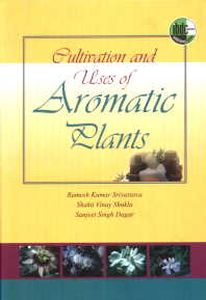
Contents: 1. Introduction. 2. Agro-climatic zones and their suitable crops. 3. Detail cultivation technology of aromatic crops. 4. Distillation technology of aromatic crops. 5. Research institutes working on aromatic crops. 6. Financing agencies. 7. Reference.
"The Indian sub-continent blessed with the world's richest resources of aromatic plant and their uses since time immemorial in different form by the collection from wild sources. India comprises its botanical wealth is about 45,000 plant species including 18,500 flowering and essential oil bearing plants. The aromatic plants are the main source of essential oils which is complex mixture of naturally occurring odoriferous compounds that exists in form of oil glands of flowers, leaves wood, barks, roots and seeds. Chemically essential oils are hydrocarbons and oxygenated hydrocarbons which can be grouped into terpenes, esters, alcohols, aldehydes, ketones phenols etc. In other words, essential oil are volatile extracts of plants used as base material in perfumes (fragrances and flavours) cosmetics aromatherapy attars and aromatherapy.
Presently, fragrant raw materials are collected from wild and well as cultivated sources for completing the demand of the perfumery and cosmetic industry. This demand in organized sector of industry has led to their introduction into agriculture which besides meeting the demand and reasonable price has also enable the produces to maintain standards on yield quality, potency and chemical constituents of the produce. A large number of aromatic plants have thus come under systematic research efforts through multi-disciplinary investigations in India since independence. This activity has generated a wealth of valuable information on several facets of agricultural productivities like crops improvement, introduction of improved agro-technologies, extraction methodology, faster instrumental analysis, product development and multifarious uses of essential oils and their produce. This material is widely scattered in research journals, proceedings of seminars and symposia, technical bulletins, monographs and technology papers. We have made an efforts to bring all this information together in the form of a book "Cultivation and Uses of Aromatic Plants" for associated farmers, entrepreneurs, students, researchers, traders, exporters, user industries and libraries.
In day-to-day health care needs undisputed role aromatic plants and its essential oils is of utmost important and these have to cultivated and propagated, because it has necessitated to reduce the pressure on natural resources, as forests, till date, continue to provide major share of raw material to the perfumery, pharmaceutical and other related industries and to check the use of spurious substitutes and adulterants, which have resulted in the deterioration of the standard of the products and preparations. The systematic and large scale cultivation and processing is only solution for providing genuine raw material for associated industries and minimize the over-exploitation of our genetic resources from forests.
The present book deals with improved cultivation and post-harvest technologies of 15 major aromatic plants, distillation technologies and their diverse uses based on experimental work and available authentic literatures".